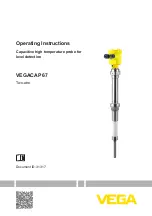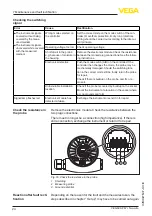
13
4 Mounting
VEGACAP 67 • Two-wire
31317-EN-200929
applies mainly to outdoor mounting as well as installation in areas
where high humidity is expected (e.g. through cleaning processes) or
on cooled or heated vessels.
To maintain the housing protection, make sure that the housing lid is
closed during operation and locked, if necessary.
Fig. 4: Measures against moisture ingress
The process fitting must be sealed if there is gauge or low pressure
in the vessel. Before use, check if the sealing material is resistant
against the measured product and the process temperature.
The max. permissible pressure is specified in chapter "
Technical
data
" or on the type label of the sensor.
Metal vessel
Make sure that the mechanical connection of the probe to the vessel
is electrically conductive to ensure sufficient grounding.
Use conductive seals, such as those made of copper or lead, etc.
Insulating measures, such as covering the thread with Teflon tape,
can interrupt the necessary electrical connection with metal vessels.
For this reason, ground the probe on the vessel or use a conductive
seal material.
Non-conductive vessels
In non-conductive vessels, e.g. plastic tanks, the second pole of the
capacitor must be provided separately.
Metric threads
In the case of instrument housings with metric thread, the cable
glands are screwed in at the factory. They are sealed with plastic
plugs as transport protection.
You have to remove these plugs before electrical connection.
NPT thread
In the case of instrument housings with self-sealing NPT threads, it is
not possible to have the cable entries screwed in at the factory. The
free openings for the cable glands are therefore covered with red dust
protection caps as transport protection.
Prior to setup you have to replace these protective caps with ap-
proved cable glands or close the openings with suitable blind plugs.
Pressure/Vacuum
Vessel material
Cable entries - NPT
thread
Cable glands














































